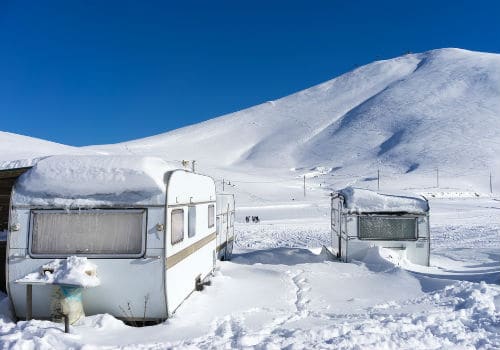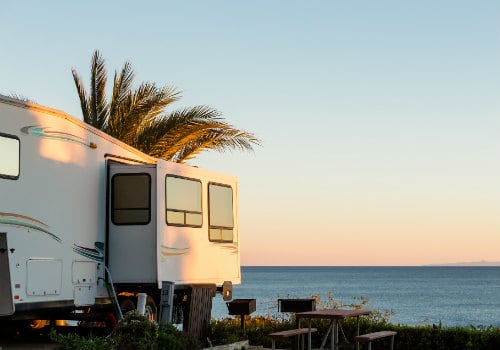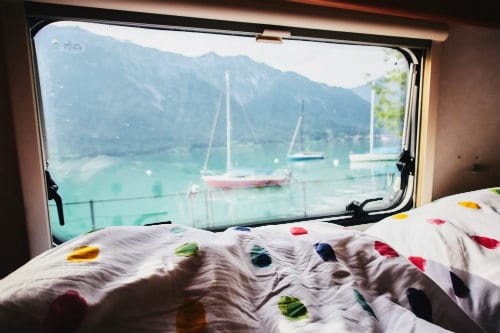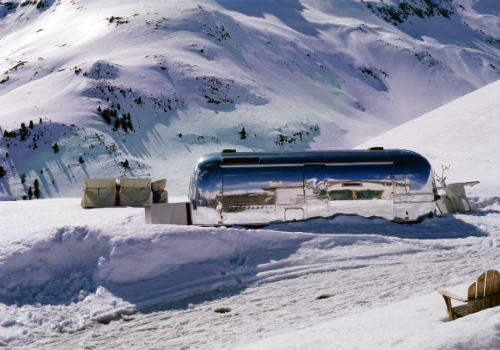There Are Low-Cost Alternatives for Heating Your RV
How to heat an RV without propane? You can use portable heaters and passive heating. There are also several other ways to easily heat an RV without propane. Even if you continue to use your RV’s propane heater, the following tips can help reduce your need for propane this winter.
How to Stay Warm in an RV
First, let’s cover a few logical steps that won’t cost you any money.
Staying warm inside your RV is similar to staying warm inside your house. Remember, this is camping. Be prepared before you leave on your trip, by packing winter-appropriate clothing and bedding.
#1 – Wear Warm Clothes

Dressing in comfortable layers can keep you warm and toasty, both inside and outside the RV.
Sweat pants and polar fleece, worn over thermal undies is both warm and comfortable. A down vest is also nice way to keep warm inside.
Don’t go barefoot inside your RV, wear warm wool socks inside. A pair of comfortable slippers is also a good idea to keep you warm inside the RV.
#2 – Pile on the Blankets
Just as you layer your clothes, layer on the blankets. This will easily keep you warm at night. Likewise, bring along several thin blankets, which can be layered on and off as the weather changes.
#3 – Use an Electric Blanket
For many RVers, an electric blanket is an indispensable accessory for winter camping. In fact, a good electric blanket can actually save on propane and electricity over the winter months. Of course, an electric blanket is a good option when you have electric hookups.
- Fast Heating & Comfort Soft Flannel: With double-sided flannel...
- Easy Operation & Smartly Designed: The heated throw have a fixed...
- Machine Washable & Care Instructions: The detachable controller...
- Unsurpassed Comfort: The length of the electric throw blanket...
- Loveable Warm Gift: In these cold months, What a heart-warming...
Types of Heaters to Use in an RV
The same type of small space heaters you use in your house can be used inside your RV. Keep in mind, electric heaters require a lot of electrical power, and are best used while plugged in with full hookups. If you attempt to run an electric heater while dry camping, you seriously risk draining your batteries.
Let’s look at a few different types of heaters commonly used inside an RV.
#1 – Ceramic Space Heater
A ceramic space heater is an efficient and safe way to heat the small spaces inside an RV. Of course, these heaters require electricity, so you’ll probably need to be plugged in at a campground.
- Ceramic Heater Elements: ceramic portable space warmer combined...
- Overheat & Tip-Over Protection: "Overheat Protection" will...
- Small & Portable: our space heater for indoor use - house,...
- Low Noise: mini heater noise is ~30 dB (quieter than a laptop),...
- Flame Retardant Material: made of high-quality heat resistant...
#2 – Catalytic Propane Heaters
These are small, efficient and quiet, with no open flame. They do not require electricity, so they can easily be used while dry camping.
#3 – Heat Pumps
Heat pumps run on electricity, but are far more energy-efficient than other types of electric heaters. However, they may not warm your RV sufficiently in very cold, freezing temperatures.
#4 – Portable Propane Heater
While technically still propane, these portable heaters use the small one-pound bottles of propane. They work with a small pilot flame, heating a ceramic plate. They are generally safe and do not require electricity.
- PORTABLE HEATER: Portable propane heater designed for emergency...
- HEAT SPACE: Perfect for heating enclosed spaces up to 225 square...
- PROPANE GAS: For use with propane gas; Runs off a 1-pound...
- FEATURES: Includes Piezo igniter, Accidental tip-over safety...
- SPECIFICATIONS: 4,000 or 9,000 BTU per hour; Run time (max BTU):...
#5 – Wood Stove
Believe it or not, some RVers actually heat their RVs with very small and efficient wood stoves.
You’ll need enough room to install a wood stove safely. To safely install a small wood stove, you’ll need an area in your RV that is clear of clutter and can be tiled with ceramic or metal. You’ll also need to install the ducts to the outside, to vent the stove.
#6 – Radiant Electrical Heating
This involves heat strips installed in the flooring of the RV. Some high-end RV models come with this as standard equipment. However, this would be a costly and complex option to install yourself.
Passive Heating Options for Your RV
There are many ways to heat your RV without the use of heaters naturally. Passive heating involves using the sun, during the day, to heat your RV living space. In milder winter climates, passive solar heating may be all you need.
Even if you use a heater, passive heating techniques can add warmth to your living space for no additional cost.
#1 – Windows

Just as the windshield on your motorhome can make summer unbearably hot, the windshield can also be used to heat your RV effectively. The best strategy for using your windows to heat the RV is to point the largest windows to the south and west.
Many RVers use Reflectix in the windows to keep the heat out in the summer. However, you can use it to keep the heat in during the winter. Once the sun begins to go down and your windows begin to cool, put your Reflectix up to keep the heat inside your living area.
Likewise, just as your day/night shades can keep heat out, you can put your day/night shades down to keep the heat in. Place Reflectix underneath the day/night shades for added insulation. Additionally, you can add a layer of insulating curtains to keep you both warm in the winter and cool in the summer.
#2 – Insulation
Adding insulation to key areas inside your RV is an economical and effective way to trap heat in.
If you frequently camp in very cold areas, you could also install additional foam insulation into the walls and ceilings. It may be possible to inexpensively blow foam insulation into the hollow spaces of your ceiling and walls.
Let’s explore a few insulation ideas for your RV.
#3 – Vents
The overhead vents and fans in your RV can allow heat to escape. You can insulate the vents in two ways; you can use a vent insulator or styrofoam. An added benefit to insulating your vents is during the cool summer air will be trapped inside.
You can purchase pre-cut vent insulators, either online or at an RV store. You’ll need to get one for every vent in your RV. Also, don’t forget to insulate the shower skylight, if you have one.
The second option is styrofoam. Cut the styrofoam to fit the vent exactly, and press it in. You may also need to secure the styrofoam in place with painter’s tape.
#4 – Doors
The logical and easy solution is to keep the doors closed in winter, to keep the heat in.
However, if you enjoy letting light in with the screen door, there is a way to insulate it. Simply wrap the screen door with heavy-duty plastic wrap and secure it with tape. Of course, if it’s very cold outside, you’ll want to keep the screen door shut too.
You can further insulate doors by hanging an insulating curtain in front of the doors. You can also use insulating “snakes,” also called draft stoppers, to keep out drafts. These items are made of cloth and are stuffed like a pillow or stuffed toy.
#5 – Rugs
If your RV does not have carpeting, get some throw rugs. Throw rugs can add a layer of insulation to your floors and keep your feet warm. Place throw rugs in all areas of your RV living space.
RV Air Leaks

Before you even worry about what type of heater to use, you need to find and address your air leaks. These occur around windows, doors and vents.
First, make sure the rubber gaskets around your exterior windows, doors and vents are in good shape. If they are worn, replace or repair them.
Next, look for any other areas that may allow cold air in. Air leaks can also happen around the edges of cabinets, closets and appliances.
You can plug small air leak areas with silicone sealer or spray foam insulation.
For larger areas, such as around cabinets and appliances, you can use painter’s tape. This is an ideal temporary solution, as the tape can easily be removed when not needed.
#1 – RV Wind Skirting
If you will be parked for weeks or months in the same spot, skirting the outside of your RV is an excellent idea. This involves blocking off the empty space underneath the RV from cold air and winds.
Cold air and wind blowing across the bottom of your RV will definitely defeat your other options for keeping your RV warm.
#2 – Soft Wind Skirting
Soft skirting can be accomplished several different ways. The easiest is purchasing wind skirting online or at an RV store.
Purchased wind skirting is often insulated, and comes in ten-foot lengths. Wind skirting is fastened to the RV with snaps. This means you will need to install the snaps onto the body of your RV.
Purchased wind skirting can also be quite expensive. The ten-foot lengths typically cost anywhere from $80-100 each. Covering a 30′ RV could cost close to $800 or more.
You can make vinyl or canvass wind skirting yourself. However, this can quickly become a bigger and more expensive DIY project than originally thought. You may need a sewing machine and tools to apply grommets and snaps.
- MADE FOR SPECIALIZED FINISHES: This versatile boat polish clears...
- POWERFUL FORMULA: While diminishing polishing compound abrasives...
- RESTORE COLOR: Restore the original color of older fiber glass...
- SAFE ON SURFACES: The abrasives in this fiberglass restorer for...
- USE IT YOUR WAY: Our Marine and Rv exterior scratch compound...
Many people improvise RV wind skirting with rolls of Reflectix. However, you will also need to improvise a way to keep the Reflectix in place, especially in windy areas. You might try painter’s tape, which will peel off easily when you’re ready to roll.
#3 – Hard Wind Skirting
Other skirting options are plywood, foam insulation board and hay bales. These solid options are best if you plan to stay in one spot for months at a time.
Plywood is very durable and can last for years. It is relatively inexpensive. However, it can cost up to $200-300. You may also need to invest in a power saw in order to cut it to fit.
On the other hand, the foam insulation board is easier to work with. It’s also inexpensive. Unfortunately, the foam insulation board will begin to deteriorate out in the elements.
One popular and unique skirting option is hay bales; they’re inexpensive and provide heavy-duty insulation. Hay bales are also bio-degradable. At the end of the season, you could even donate the hay bales to a needy horse or cow!
However, a big downside to hay bales is mice. Yes, mice. They love to burrow into the warm, yummy hay, and make nests.
In turn, the mice can make their way into the inside of your RV. Obviously, this would not be a good thing. You may solve your heating issue, and end up with a rodent issue.
Other Questions Answered About RV Camping in Cold Weather.

Is running an electric heater while dry camping really out of the question? Yes. You also need to know that your house batteries can drain very quickly in cold weather. Freezing weather is very hard on both vehicles and RV batteries. Plugging in at an RV park is the best option for winter RV living.
Will my holding tanks freeze, if I heat the inside of the RV? That depends. It’s not uncommon for the freshwater tank to be under the dinette, so that won’t freeze. However, prolonged freezing temperatures can freeze your gray and black tanks solid. That’s one reason why skirting an RV is advisable.
Related to freezing tanks, is freezing water hoses. If you are staying in an area with freezing temperatures day and night, purchase an insulated and heated water hose. If it only freezes at night, unhook your hose before bed and turn on the water pump.
- 15 Square Foot Under Tile Heating Mat, Mat is 20” Wide x 9’...
- Mat has double sided tape (Adhesive Backing) to stick to floor....
- 120V, 1.5 Amp, 180W, 12 Watts/Sqft, UL Listed for USA and Canada,...
- Digital Programmable Thermostat # TH115-AF-120, Includes 2 floor...
- Made in the USA using the highest quality materials, Single Cold...
Is winter camping as common as snowbird camping? No. Quite simply, RVs are designed and built for warm weather. Also, many popular camping areas are closed in the winter. Before you venture out into the snow, make sure you will have a safe place to park and plug-in.
Product data was last updated on 2024-04-16 at 12:28.









